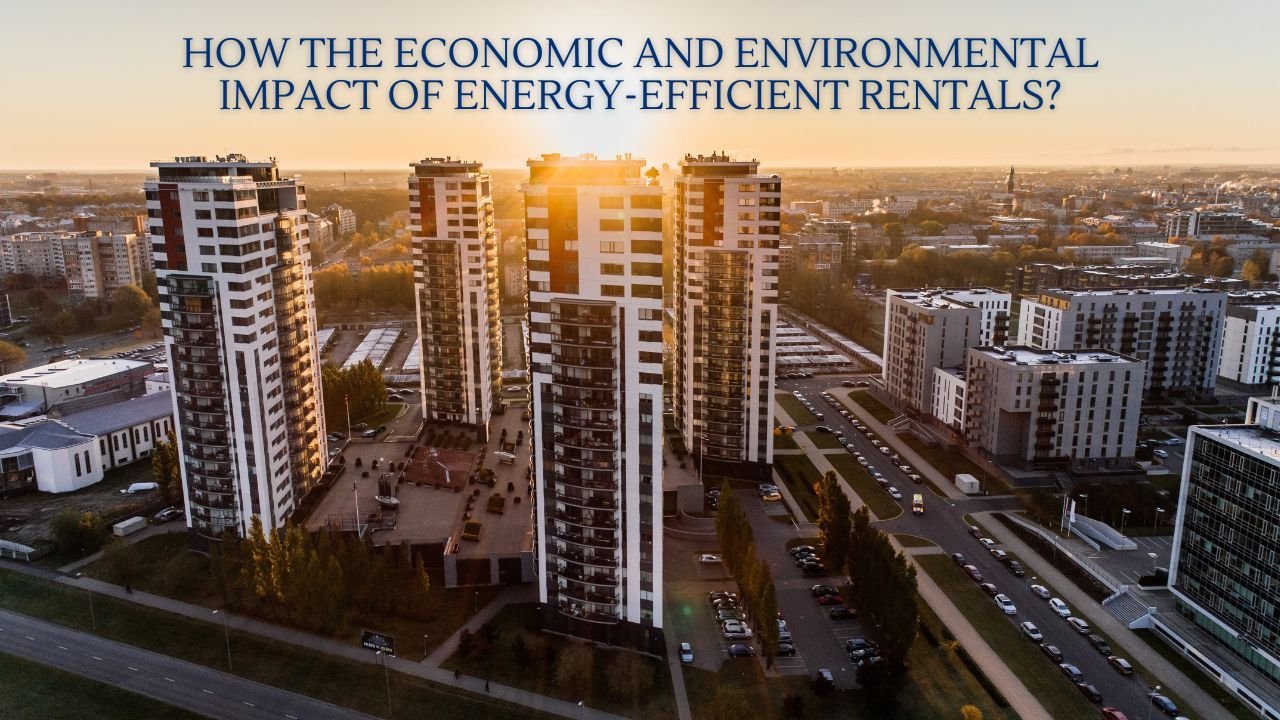In the ever-evolving landscape of real estate, a pivotal shift towards sustainability is taking place, particularly evident in the rise of energy-efficient rentals. This article delves into the economic and environmental impact of energy-efficient rentals, exploring how these practices are not only reshaping the real estate industry but also contributing to a more sustainable and economically resilient future.
Economic Advantages of Energy-Efficient Rentals

Tenant Savings and Affordability
As highlighted by the U.S. Department of Energy (DOE), the adoption of energy-efficient practices can lead to substantial cost savings for individuals residing in such accommodations. The DOE’s estimates underscore the potential impact of measures like proper insulation, efficient heating, ventilation, and air conditioning (HVAC) systems, along with the use of ENERGY STAR-rated appliances.
According to DOE calculations, the combined implementation of these energy-efficient features has the potential to reduce utility bills by an impressive 30%. This significant reduction in ongoing expenses can have a transformative effect on the affordability of living in energy-efficient rentals, specifically examining the economic and environmental impact of energy-efficient rentals. For tenants, the prospect of saving a substantial portion of their monthly income on utility costs makes these rentals an increasingly attractive and viable housing option.
Moreover, the affordability aspect of energy-efficient rentals resonates across a diverse demographic. This housing option appeals not only to environmentally conscious individuals but also to those seeking practical ways to manage their household budgets more effectively. As a result, energy-efficient rentals contribute to fostering inclusive communities where residents from various socio-economic backgrounds can access high-quality, cost-effective housing.
Increased Property Value

The economic and environmental impact of energy-efficient rentals extends beyond the immediate benefits for tenants and permeates the broader real estate market, creating a ripple effect that positively impacts property owners. The U.S. The Environmental Protection Agency (EPA) plays a pivotal role in highlighting these advantages, particularly through its ENERGY STAR program.
The ENERGY STAR program, championed by the EPA, serves as a beacon for promoting energy efficiency in homes. It goes beyond the immediate goal of reducing energy consumption by emphasizing the long-term economic benefits for property owners. Homes that receive ENERGY STAR certification are not only recognized for their eco-friendly features but are also positioned as valuable assets in the real estate market.
According to the EPA’s findings, properties with ENERGY STAR certification can command a premium in the real estate market, experiencing an increase in value of approximately 9%. This statistic underscores the notion that the economic and environmental impact of energy-efficient rentals translates into not just short-term cost savings for tenants but also tangible and enduring financial gains for property owners.
The heightened market value of energy-efficient properties is rooted in the growing awareness and demand for sustainable living among homebuyers. Prospective buyers are increasingly prioritizing the economic and environmental impact of energy-efficient rentals as a key consideration in their purchasing decisions. Energy-efficient homes not only signify reduced environmental impact but also promise long-term economic prudence, given the lower operational costs associated with efficient energy use.
For property owners, this translates into a strategic investment that pays off in multiple ways. Beyond the initial costs of implementing economic and environmental impact of energy-efficient rentals upgrades, the long-term appreciation of property value serves as a lucrative return on investment. Property owners can benefit not only from the improved market position of their assets but also from the growing pool of environmentally conscious buyers actively seeking homes with sustainable features.
Government Incentives and Tax Credits

The robust economic foundation of energy-efficient rentals, specifically examining the economic and environmental impact of energy-efficient rentals, is further fortified by the comprehensive support provided by government incentives and tax credits. The Database of State Incentives for Renewables & Efficiency (DSIRE) stands as a pivotal resource that sheds light on the myriad financial benefits available to property owners who choose to invest in the economic and environmental impact of energy-efficient rentals.
DSIRE serves as a comprehensive repository of state-level incentives, offering property owners valuable insights into the various financial mechanisms put in place to encourage the adoption of the economic and environmental impact of energy-efficient practices. One of the primary forms of support comes in the guise of federal tax credits, which are instrumental in alleviating the financial burden associated with implementing economic and environmental impact of energy-efficient upgrades. These tax credits serve as tangible rewards for property owners who take proactive steps toward creating more sustainable and eco-friendly living spaces.
In addition to federal tax credits, state rebates represent another facet of the financial incentives provided by governments. These rebates are designed to directly offset the costs incurred during the installation of the economic and environmental impact of energy-efficient systems, thereby making such upgrades more financially feasible for property owners. The combination of federal tax credits and state rebates creates a synergistic support system that not only promotes energy efficiency but also stimulates economic activity within the housing sector.
Furthermore, the incentives offered by governments extend beyond mere financial relief. They serve as a powerful motivator for property owners to embrace the economic and environmental impact of energy-efficient practices, aligning with broader environmental and energy policy objectives. This symbiotic relationship between government incentives and property owner actions reinforces the commitment to fostering a more sustainable and energy-efficient housing market.
The government’s active role in supporting the economic and environmental impact of energy-efficient initiatives reflects a broader commitment to addressing environmental challenges and promoting responsible resource use. By offering financial incentives, governments aim to accelerate the adoption of eco-friendly technologies, ultimately contributing to a reduction in overall energy consumption and a decrease in economic and environmental impact.
As the energy-efficient housing market continues to grow, government incentives and tax credits play a crucial role in shaping the trajectory of sustainable development. Property owners, encouraged by the prospect of financial benefits and guided by regulatory support, become integral partners in the collective effort to build a more economically resilient and environmentally conscious housing sector.
Environmental Impact of Energy-Efficient Rentals

Reduced Carbon Emissions
The economic and environmental impact of energy-efficient rentals extends far beyond the confines of individual buildings, contributing significantly to the overarching goal of reducing carbon emissions and mitigating the impact of climate change. The U.S. Green Building Council (USGBC) stands as a prominent authority, offering compelling data that underscores the pivotal role of energy-efficient buildings in this critical endeavor.
According to the USGBC, green buildings, which include energy-efficient rentals, have the potential to achieve a substantial reduction in carbon emissions, amounting to an impressive 34%. This figure represents not just a statistical metric but a tangible manifestation of the economic and environmental impact of energy-efficient practices in the construction and maintenance of residential properties.
The significance of this reduction in carbon emissions cannot be overstated, especially in the context of global efforts to address climate change. Energy-efficient rentals, by minimizing their carbon footprint, align with the broader commitment to sustainability and environmental responsibility. As nations grapple with the consequences of climate change, the role of economic and environmental impact of energy-efficient housing becomes increasingly vital in achieving and surpassing national sustainability targets.
The reduction in carbon emissions is a result of various economic and environmental impacts of energy-efficient features integrated into green buildings. These features include advanced insulation materials, energy-efficient heating, ventilation, and air conditioning (HVAC) systems, as well as the incorporation of renewable energy sources. Collectively, these measures contribute to a significant decrease in the overall energy consumption of the building, translating into lower greenhouse gas emissions.
Furthermore, the positive impact of reduced carbon emissions from the economic and environmental impact of energy-efficient rentals extends beyond individual properties. It resonates at the community and national levels, influencing the broader environmental landscape. Communities that prioritize the economic and environmental impact of energy-efficient practices not only contribute to a healthier and more sustainable local environment but also set an example for other regions to follow suit.
Water Conservation

The Environmental Protection Agency’s (EPA) WaterSense program adds another layer of environmental sustainability to the discourse on the economic and environmental impact of energy-efficient rentals, highlighting the interconnectedness of water conservation and energy-efficient building practices. Recognizing the pivotal role that water plays in our daily lives and the broader ecosystem, the WaterSense program underscores the critical importance of integrating water-saving features into the design and construction of the economic and environmental impact of energy-efficient rental properties.
Energy-efficient rentals, often championing a holistic approach to sustainability, embrace water-saving fixtures and appliances as integral components of their eco-friendly design. These fixtures go beyond the conventional focus on energy consumption, extending their impact to responsible water management. According to the EPA, homes labeled with WaterSense certification exhibit a remarkable 20% reduction in water usage compared to their traditional counterparts.
The incorporation of water-saving technologies in the economic and environmental impact of energy-efficient rentals involves the deployment of advanced plumbing fixtures, such as low-flow toilets, faucets, and showerheads. These fixtures are designed to optimize water usage without compromising functionality, ensuring a seamless transition to more sustainable living. Additionally, the economic and environmental impact of energy-efficient appliances within these rentals often feature water-saving functionalities, contributing to the overall reduction in water consumption.
The significance of this water conservation aspect in the economic and environmental impact of energy-efficient rentals is two-fold. Firstly, it aligns with the overarching goal of responsible resource management. Water, as a finite resource, faces increasing challenges due to population growth, climate change, and competing demands across various sectors. By reducing water consumption, the economic and environmental impact of energy-efficient rentals actively contributes to preserving this precious resource for current and future generations.
Secondly, the integration of water-saving features complements the broader environmental conservation efforts. Water scarcity is a global concern, and reducing unnecessary water usage in residential buildings becomes a tangible and impactful way to address this challenge. By being WaterSense-labeled, the economic and environmental impact of energy-efficient rentals not only meet high standards of efficiency but also advocate for sustainable water practices, creating a ripple effect that extends beyond individual properties to influence community-wide conservation initiatives.
In a world where sustainable living practices are gaining prominence, the collaboration between energy efficiency and water conservation in the economic and environmental impact of energy-efficient rentals becomes a strategic imperative. Beyond the immediate benefits of reduced utility costs for tenants, the incorporation of water-saving features aligns with the growing societal awareness of the interconnectedness of environmental issues. The economic and environmental impact of energy-efficient rentals, with their dual focus on energy and water conservation, emerge as beacons of responsible and conscious living, setting new standards for eco-friendly housing and reinforcing the idea that every drop saved contributes to a more sustainable and resilient future.
Advancement of Green Building Standards
The U.S. Department of Housing and Urban Development (HUD) stands at the forefront of championing sustainability in the real estate sector, acknowledging the transformative impact that the economic and environmental impact of energy-efficient rentals can have on both individual properties and the industry as a whole. HUD’s commitment to advancing green building practices is reflected in its recognition of the pivotal role played by the economic and environmental impact of energy-efficient rentals in adhering to and shaping these evolving standards.
According to data from HUD, the economic and environmental impact of energy-efficient rentals not only meet but actively contribute to the progression of green building standards. These standards encompass a wide array of factors, including energy efficiency, water conservation, indoor air quality, and the use of sustainable materials. By embracing these guidelines, the economic and environmental impact of energy-efficient rentals position themselves as pioneers in the ongoing evolution of sustainable construction and housing practices.
One key aspect of the evolution is the adoption of sustainable construction practices. The economic and environmental impact of energy-efficient rentals often goes beyond the basic requirements, incorporating environmentally friendly building materials, efficient insulation, and advanced construction techniques. This not only ensures compliance with existing green building standards but also sets a precedent for innovative and eco-conscious approaches that can inspire future developments within the real estate industry.
Furthermore, the integration of resource-efficient technologies within the economic and environmental impact of energy-efficient rentals plays a crucial role in shaping the trajectory of green building standards. The use of economic and environmental impact of energy-efficient HVAC systems, smart home technologies, and renewable energy sources contributes to the overall reduction of the environmental footprint of these properties. As a result, the economic and environmental impact of energy-efficient rentals become living examples of how technology and sustainability can coalesce to create residences that are not only comfortable for occupants but also gentle on the planet.
By serving as catalysts for positive change, the economic and environmental impact of energy-efficient rentals influences the broader real estate industry. Developers and builders, inspired by the success and market demand for these eco-friendly properties, are prompted to adopt similar sustainable practices in their projects. This ripple effect ensures that the influence of the economic and environmental impact of energy-efficient rentals extends beyond individual properties, fostering a culture of environmental consciousness within the real estate sector.
HUD’s recognition of the significance of the economic and environmental impact of energy-efficient rentals in the context of green building standards underscores a shared commitment to sustainable urban development. As cities and communities grapple with the challenges posed by climate change and resource depletion, the adoption of green building practices becomes not just a choice but a necessity. The economic and environmental impact of energy-efficient rentals, by actively participating in this evolution, contribute to the creation of resilient and environmentally responsible housing options that align with the changing expectations of tenants and the broader societal shift toward sustainable living.
Conclusion
In conclusion, the economic and environmental impact of energy-efficient rentals, backed by specific data from esteemed US government agencies, underscores their transformative potential. With tangible tenant savings, increased property values, and a clear commitment to environmental stewardship, energy-efficient rentals emerge not only as a sustainable housing solution but as a cornerstone for a resilient and green future. Embracing these practices aligns with the vision set forth by government agencies, making them an indispensable aspect of the nation’s journey toward a sustainable and economically robust tomorrow.











